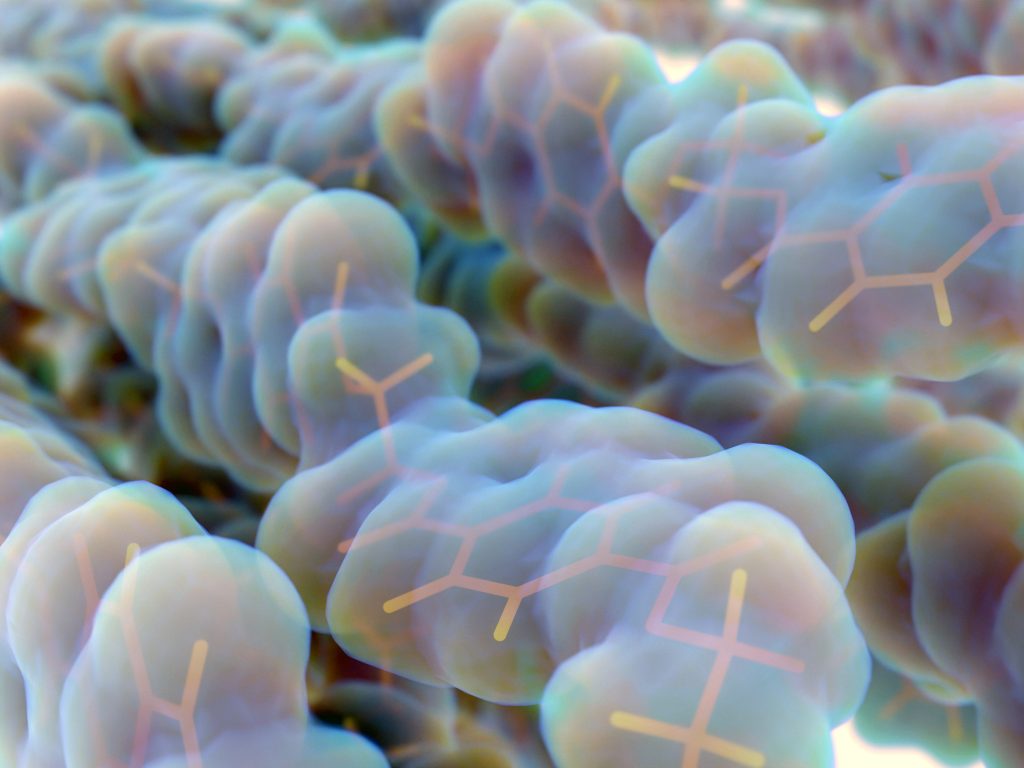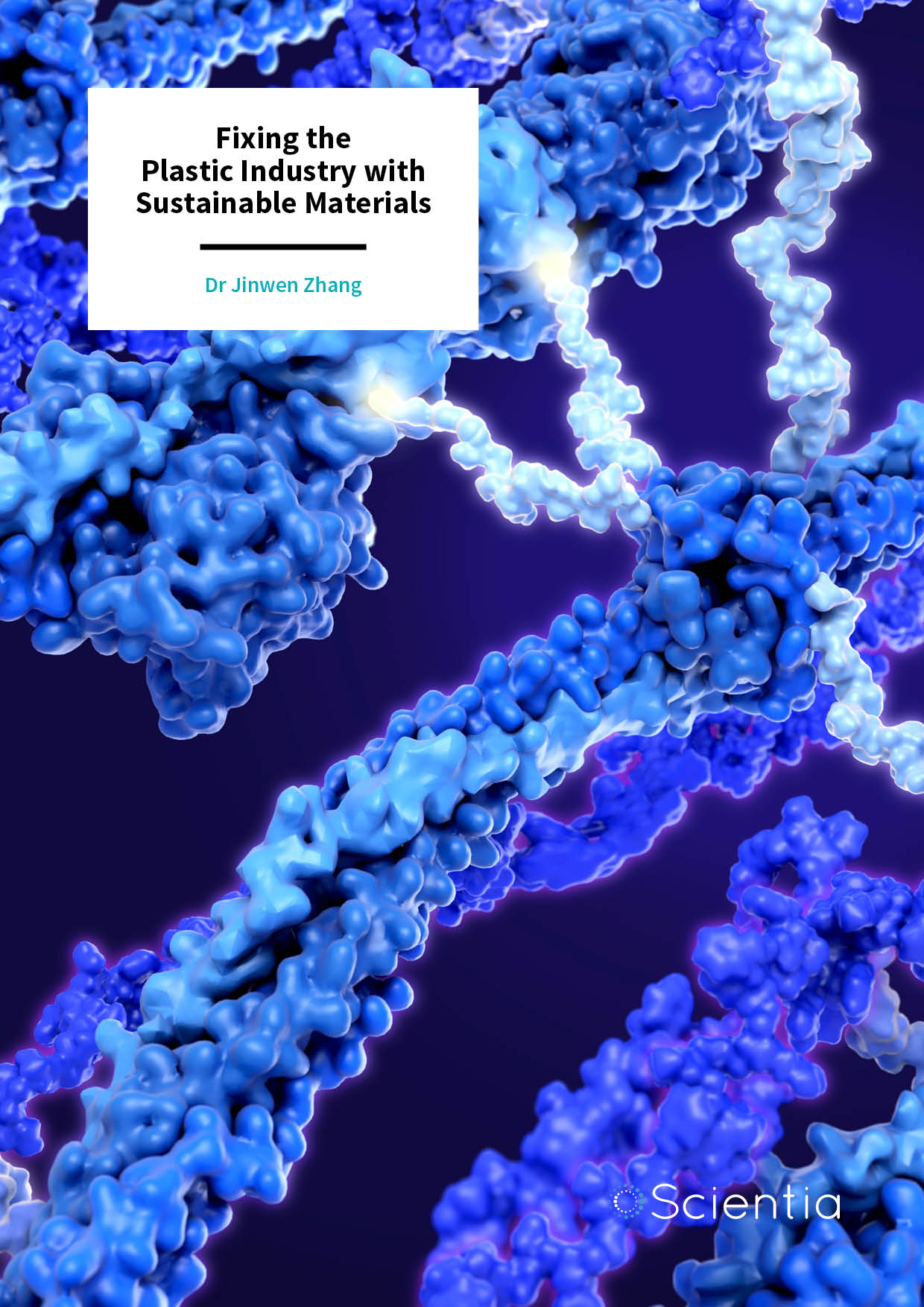Dr Jinwen Zhang | Fixing the Plastic Industry with Sustainable Materials
A combination of dwindling oil reserves and increasing pollution means that the plastic industry must be urgently transformed before it’s too late. The efforts of researchers, including Dr Jinwen Zhang and his colleagues at Washington State University, mean that solutions are becoming increasingly available. Through the development of malleable and self-healable plastics, created from both existing petrochemical and renewable chemical feedstocks, Dr Zhang’s team is creating stronger, more resilient plastics that can be easily recycled.
The Need for Sustainable Materials
Since the mid-20th century, our societies have become increasingly dependent on plastics. It’s easy to see why: they are strong and stable, cheap and easy to produce, and can be readily modified and moulded for their intended use. In many ways, plastics are the ideal materials.
Of course, we now know that plastics are far from perfect. Most plastics are petroleum-based, meaning that the starting materials used to make them come from crude oil. Like all fossil fuels, crude oil resources are dwindling and are inherently unsustainable, meaning that we should look to alternative, renewable sources for producing plastics.
Another major problem with plastics is their longevity. We have all heard about how long it can take for a plastic bag or toothbrush to break down naturally, and other plastic items are no exception. When they can’t be recycled, these items end up in landfill or even the ocean, contributing to the already astronomical levels of pollution released into the environment every year.
If we want to keep using plastics, we need to seriously rethink how they are made, while also ensuring that they can be safely recycled or biodegraded after they have served their purpose. Scientists all over the world have dedicated their careers to this problem, with the hopes of creating new solutions for a sustainable future.
Dr Jinwen Zhang and his team at Washington State University are at the forefront of this research. These researchers are working tirelessly to develop interesting new materials that are not only produced in a sustainable way, but can also help to reduce the amount of plastic waste that goes to landfill.
‘For more than 20 years, I have dedicated myself to tackling challenges in the realm of sustainable plastic materials,’ says Dr Zhang. ‘I have focused my research on the synthesis, processing, and application development of polymer materials, towards addressing the long-term sustainability of plastics.’

Developing Recyclable and Self-healing Plastics
When it comes to reducing waste, there are many possible approaches. An obvious approach is to make plastics that can be easily reprocessed – meaning that they are easy to recycle and can be made into new high-quality materials. This is impossible for many of our current plastics, such as ‘thermoset’ plastics, which have a crosslinked network structure and are used to make wind turbine blades and foam mattresses. Another approach is to create longer lasting, durable materials, which can be reused many times, reducing the need for disposable items.
A recent breakthrough in materials science offers a fantastic solution to this: recyclable and self-healable thermoset plastics. Through some innovative chemistry, it is possible to produce crosslinked plastics that have the ability to repair defects in their structures. This means that small amounts of damage in these materials can ‘heal’ themselves, allowing them to be reused far more times than traditional plastic. In addition, such plastics can be more easily recycled, as their malleability allows them to be remoulded while still maintaining their structural integrity.
The mechanism behind the malleable and self-sealing properties of these materials is rather ingenious. When heated to a suitable temperature, the molecular bonds within the material shift and new linkages form within the material. This allows the material’s constituent molecules to reconnect and patch up damaged areas. Once cooled, the material has similar properties to those of a traditional plastic, allowing it to be used across a wide range of applications. Because of the characteristic bond exchange, these plastics are also easier to chemically recycle than their traditional counterparts.
Dr Zhang and his colleagues have been developing and researching new types of malleable and self-healable materials, with the goal of creating alternative plastics that are both durable and recyclable.
Using different combinations of chemical feedstocks, the team produced a range of different plastic materials, and assessed their physical properties and recyclability. This gave them an insight into which combinations worked, and which did not. Through this extensive research, the researchers developed a range of materials with varying properties, which could repair themselves when heated.
The team also assessed how easily their new self-healing materials could be recycled. They did this by applying both physical and chemical methods to break down the plastics, before remoulding them back into solid materials and testing their physical properties. The team found that their materials could be easily broken down, and that the remoulded plastics had similar quality to the original materials, confirming excellent recyclability.
Dr Zhang and his colleagues have demonstrated how self-healing plastics can be produced through conventional means, resulting in strong, dynamic materials that can be used in diverse applications. Importantly, the team’s new plastics can also be readily recycled, making them a far greener alternative to most conventional plastics.
Creating Plastic from Hemp Oil
Another goal of Dr Zhang’s research is to reduce society’s dependence on crude oil. As previously mentioned, the majority of our plastics are made from petrochemicals derived from crude oil, meaning that these materials are inherently unsustainable.
A much more appealing alternative is to use the oils found in plants to develop new plastic materials. ‘Since I joined Washington State University in 2004, I have conducted in-depth investigations into bio-based polymer alternatives to petroleum-based plastics in several key areas, including bioplastics made from vegetable oils.’
Such vegetable oils are renewable, as plants can be grown quickly. As plants capture carbon dioxide from the air as they grow, producing plastics from vegetable oil can help to offset the carbon emissions associated with the manufacturing process. Dr Zhang and his team have been investigating how the oil from hempseed can be used in this way.
Hemp has been used throughout history as a strong and versatile material, especially when it comes to weaving clothing and other textiles from its fibres. However, it is an entirely different challenge to develop new plastics using oils extracted from the plant.
Dr Zhang and his colleagues focused once again on developing a thermoset plastic material that has dynamic chemical bonds, so that it would be more likely to exhibit malleable and self-healing properties. Such properties would make their new material long-lasting, durable and easily recycled.
After extensive research, the team’s resulting material exhibited excellent physical properties, and demonstrated the ability to be remoulded and repair its surface when scratched.
Dr Zhang has now partnered with ZILA Works to develop and commercialise an epoxy resin system made from hemp seed oil. ‘ZILA’s initial Life Cycle Assessment screening of the patented hemp-based epoxy identified a clear path to a 60% reduction in carbon footprint compared to petroleum-based epoxies,’ explains Dr Zhang.

Recycling Carbon Fibre Reinforced Polymers
Carbon fibre reinforced polymers are extremely durable materials that are a lot less heavy than metallic alternatives. Their strength and lightweight nature have made them highly desirable materials in the manufacture of boats, cars, airplanes and spacecraft.
However, the unique structure of carbon fibre reinforced polymers makes them difficult to recycle, which can ultimately lead to a lot of waste material. Dr Zhang and his team are addressing this challenge, by reinventing the recycling processes for these materials, towards significantly reducing the amount of carbon fibre reinforced polymers that goes to landfill.
While these types of processes have been performed in the past, they often require the use of nasty caustic solutions, such as nitric acid and potassium hydroxide. These substances are not only dangerous, but their usage can also create toxic by-products that actually contribute to pollution. In recent years, some milder methods for recycling these materials have been developed by treating them at high temperatures, though the results have been less than optimal.
Dr Zhang suggests a slightly different approach, whereby chemical treatment is used to break down the molecular chains that bind the material together, in a safe and efficient way. Dr Zhang’s team developed an approach that uses a milder solution: zinc salt and water. When heated, this solution can help to catalyse the breakdown of carbon fibre reinforced polymers, leading to much easier and safer recycling.
Not only was the team’s method safer, but because of the milder reaction conditions, the quality of the recycled material was much better than in previous cases. By using this method, both the recovered carbon fibre and polymer can be reused for preparation of new composite materials, so that they can be effectively recycled and used again.
A Sustainable Future
The team has recently partnered with industries to scale-up their processes, and to get their sustainable plastic materials on the market. ‘Several of our methods and technologies have now been licensed by industries and are being assessed in the initial commercialisation process,’ explains Dr Zhang.
Through a thorough understanding of chemical bonding and structural design, Dr Zhang and his team have demonstrated how we can create long-lasting, recyclable materials with the use of existing petrochemicals and renewable feedstock. This is a great step in terms of changing our relationship with plastics, and will hopefully help to create a cleaner and more sustainable world for future generations.
SHARE
DOWNLOAD E-BOOK
REFERENCE
https://doi.org/10.33548/SCIENTIA835
MEET THE RESEARCHER

Dr Jinwen Zhang
School of Mechanical and Materials Engineering
Composite Materials and Engineering Center
Washington State University
Pullman, WA
USA
Dr Jinwen Zhang began his career in dyeing and finishing at the Suzhou Institute of Silk Textile Technology, China, where he earned his BE, before obtaining his ME in technology of fine chemicals from the Dalian University of Technology, China. He then moved to the USA, where he was awarded his PhD in Polymer Science from the University of Massachusetts Lowell. Since then, he has worked as a researcher and professor at several prestigious universities, the most recent of which being Washington State University, where he holds his current position as Professor in the School of Mechanical & Materials Engineering. Here, his research focuses on developing new environmentally sustainable materials with recyclable properties. Dr Zhang has been awarded several awards of excellence, including the James Hammar Memorial Service Award, a gold medal in the Excellence in Government Award, and an Outstanding Mentor award from the Washington State University.
CONTACT
W: https://mme.wsu.edu/jinwen-zhang/
FUNDING
DOE
USDA
FURTHER READING
C Hao, T Liu, S Zhang, W Liu, Y Shan, J Zhang, Triethanolamine-Mediated Covalent Adaptable Epoxy Network: Excellent Mechanical Properties, Fast Repairing, and Easy Recycling, Macromolecules, 2020, 53, 3110.
S Zhang, T Liu, C Hao, A Mikkelsen, B Zhao, J Zhang, Hempseed Oil-Based Covalent Adaptable Epoxy-Amine Network and Its Potential Use for Room-Temperature Curable Coatings, ACS Sustainable Chemistry & Engineering, 2020, 8, 14964.
T Liu, S Zhang, C Hao, C Verdi, W Liu, H Liu, J Zhang, Glycerol Induced Catalyst-Free Curing of Epoxy and Vitrimer Preparation, Macromolecular Rapid Communication, 2019, 40, 1800889.
T Liu, X Guo, W Liu, C Hao, L Wang, WC Hiscox, C Liu, C Jin, J Xina, J Zhang, Selective cleavage of ester linkages of anhydride-cured epoxy using a benign method and reuse of the decomposed polymer in new epoxy preparation, Green Chemistry, 2017, 19, 4364.
T Liu, M Zhang, X Guo, C Liu, T Liu, J Xin, J Zhang, Mild chemical recycling of aerospace fiber/epoxy composite wastes and utilization of the decomposed resin, Polymer Degradation and Stability, 2017, 139, 20.

REPUBLISH OUR ARTICLES
We encourage all formats of sharing and republishing of our articles. Whether you want to host on your website, publication or blog, we welcome this. Find out more
Creative Commons Licence (CC BY 4.0)
This work is licensed under a Creative Commons Attribution 4.0 International License. 
What does this mean?
Share: You can copy and redistribute the material in any medium or format
Adapt: You can change, and build upon the material for any purpose, even commercially.
Credit: You must give appropriate credit, provide a link to the license, and indicate if changes were made.
SUBSCRIBE NOW
Follow Us
MORE ARTICLES YOU MAY LIKE
Dr Niloofar Vardian | Mapping the Unknown: Inside Black Holes
Dr Niloofar Vardian at the SISSA school has advanced our understanding of black hole interiors through precise mathematical modelling. Her recent publication sheds light on previously inaccessible aspects of black hole dynamics, deepening our knowledge of these mysterious and difficult-to-study phenomena.
Dr Ying Zou | A New Type of Space Storm: The Extraordinary Auroral Event of April 2023
Space weather events can have dramatic effects on Earth’s magnetic field, potentially disrupting everything from power grids to GPS systems. Dr Ying Zou and her colleagues Dr Jesper Gjerloev and Shin Ohtani from Johns Hopkins University Applied Physics Laboratory led a groundbreaking investigation into an extraordinary disturbance in Earth’s magnetic field that occurred in April 2023. This unprecedented event is reshaping our understanding of how solar activity can trigger extreme space weather that impacts our technological systems.
Renewable Fuel for a Generation of Green Batteries
Revolutionizing energy production has been integral to combatting climate change and reducing our dependence on limited natural resources, but complementary advances in energy storage have been lacking. Dr Thomas Guarr and Dr David Hickey from Michigan State University lead their team in investigating a counterintuitive molecular mechanism which could support a wave of green, renewable, and cheap batteries. If practical, this technology might be the crucial leap towards an entirely green energy system.
Deok-Young Lee – Dr Sin Hyuk Yim | Navigating the Quantum Frontier with Atom Spin Gyroscope Technology
Deok-Young Lee from the Korea Advanced Institute of Science and Technology and collaborator Dr Sin Hyuk Yim, affiliated with South Korea’s Agency for Defense Development work together to lead the advancement of quantum sensing technology. Their innovative research in developing rubidium-xenon gas cells has improved the precision and efficiency of atom spin gyroscopes, significantly driving forward the field of quantum measurement.





